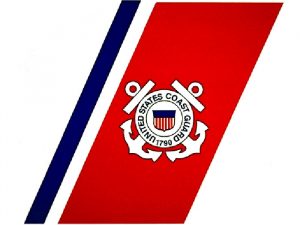
Bouchard slapped with USCG NY Captain of the Port orders
The Coast Guard Captain of the Port of New York and New Jersey has issued an order to Bouchard Transportation Company requiring that three tug and fuel barge units currently anchored in

The Coast Guard Captain of the Port of New York and New Jersey has issued an order to Bouchard Transportation Company requiring that three tug and fuel barge units currently anchored in
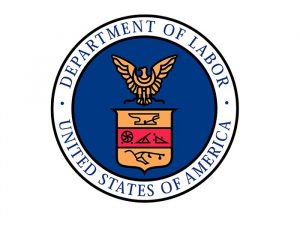
A whistleblower investigation by the U.S. Department of Labor’s Occupational Safety and Health Administration (OSHA) has found that Bouchard Transportation Company Inc., B. No. 272 Corp – a petroleum barge company based
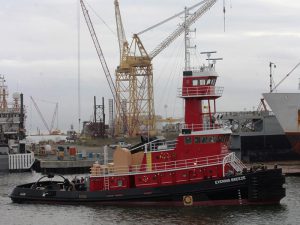
Melville, N.Y., based Bouchard Transportation Co., Inc. has taken the delivery of ATB unit M/V Evening Breeze and Barge No. 252 (B. No. 252) from shipbuilders VT Halter Marine Inc. and Bollinger
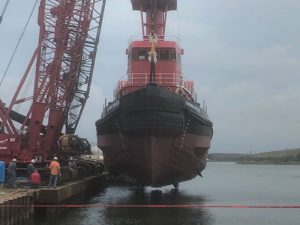
NOVEMBER 8, 2018 — Bouchard Transportation Co., Inc., Melville, NY, reports that the ATB tug M/V Evening Breeze was launched Wednesday, November 7 at VT Halter Marine, Inc.’s Pascagoula, MS, shipyard. The
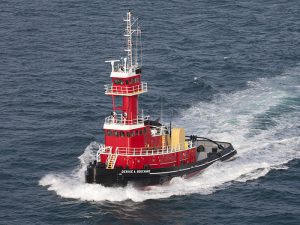
SEPTEMBER 11, 2018 — VT Halter Marine, Inc. has won a contract to build an Articulated Tug Barge (ATB) tug for Bouchard Transportation Co., Inc. The order includes an option for a
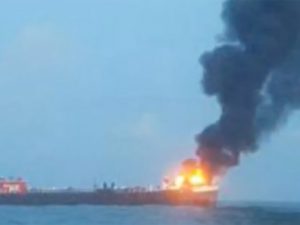
OCTOBER 20, 2017 — One person is dead and another person remains missing after a fire on an oil barge that broke out at approximately 4:35 AM this morning and was followed
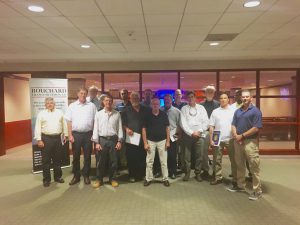
AUGUST 17, 2016 — Bouchard Transportation Co., Inc., has cooperated with SUNY Maritime College to hold a USCG Leadership & Managerial Skills Course for its vessel employees. Effective March 24, 2014, additional
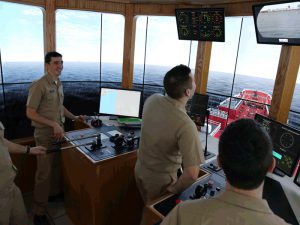
An increasingly technical world – on board and ashore – and a growing mariner shortage have conspired to make maritime education and training more important than ever. The maritime world plays a significant role in moving the global economy and its goods, people and power. Educational institutions ensure those responsible for moving the world’s assets across the seven seas are well-qualified and prepared for their roles.
According to the latest BIMCO and ICS manpower report, the industry is facing a need for nearly 150,000 officers in the next decade and is already short 16,000 officers. The need to keep men and women sailing on their licenses for longer, and to recruit and train new officers, is growing steadily. In times of high demand, it is not unknown for the quality of a product to decrease. Yet that is an unconscionable risk for the maritime industry and its regulatory agencies. In fact, requirements to earn and upgrade a license are becoming more stringent, meaning that maritime educators must take additional steps to ensure the necessary requirements are met for all entering the fleet.
Additionally, vessels and operating procedures are becoming increasingly complicated; it is imperative that the men and women in charge of them and their cargo know what they are doing.
At SUNY Maritime College in New York City, the professional education and training department is responsible for giving professional mariners the continuing education they need to stay current and qualified under changing regulations. The program also trains students for limited tonnage licenses, playing an important role in the nation’s brownwater fleet.
For more than 100 years, SUNY Maritime has educated and trained merchant mariners, changing its curriculum, facilities and program offerings to align with the needs of the industry and U.S. Coast Guard requirements. Once again, the college is working to meet the growing mariner demand and to ensure that they succeed in their pursuit of Coast Guard mariner credentials.
The changes – among others – include offering additional courses to help licensed mariners maintain and update their skills as well as building facilities to train new mariners. The Manila amendments to the International Convention on Training, Certification and Watchkeeping standards, approved in 2010, go into effect at the end of the year. Safety is, and always will be, paramount to the maritime landscape, and the Manila amendments are designed to enhance crew safety at sea.
The amendments require, among other things, that all mariners take regular courses in basic training, renew their endorsements, and pass leadership courses to upgrade and maintain their credential.
No longer is experience at sea enough.
Basic training, which covers all the subjects most important to a vessel’s safety, still teaches basic firefighting, personal survival techniques, personal safety and social responsibility, and basic first aid. But now mariners will need to take the course, or a version of it, every five years in their professional careers.
After the end of the year, mariners entering the profession will take the original 40-hour course that has been taught for years and which introduces them to onboard safety operations. A 16-hour refresher course will be required for all who have not accrued 360 days of sea time in the past five years. An 8-hour course has been designed for mariners who have accrued the 360 days in a five-year period.
Nor is it enough anymore to earn lifeboatman, fast rescue boat or tankerman-PIC endorsements once and carry them for life. Once the Manila amendments go into effect, mariners must renew these qualifications to keep them.
These courses are being developed by a variety of players, including state maritime academies like SUNY Maritime.
Industry professionals, executives and thought-leaders have always prized safety over all else—safety of their crews, their vessels and, lastly, of their cargo. But tragedies like the sinking of the El Faro serve as an unfortunate reminder to all of us of how dangerous our industry can be and how necessary these skills are for the well-being of all who sail.
Safety practices and awareness are, of course, the most important thing that maritime educators impart to their students. This is a dangerous field and there are too many things that can go wrong.
But the Manila amendments have also recognized the increasing importance of a second set of skills related to teamwork and leadership, not only for those in leadership positions but for all officers onboard a vessel.
The essence of Coast Guard licensure training, at SUNY Maritime and elsewhere, is focused on developing mates and engineers who can work together and make decisions. The Coast Guard requires a regimented lifestyle and, though interpretations of that lifestyle vary, the focus is in developing an individual’s character and leadership skills so that the safety of the crew and vessel are paramount, rather than individual wants and needs.
But the regimental program at SUNY Maritime, in keeping with STCW standards, now includes leadership and teamworking training, while professional mariners can come to the campus to take the individual course. The course will focus on case studies, workload management, maritime conventions and regulations, and situational awareness to enhance decision making skills.
STCW standards also include training for those looking to advance into personnel management positions on both the deck and engine sides of vessel operations. More training has been added to ensure that officers can work together to, once again, ensure the vessel’s operations go as smoothly and safely as possible. The 35-hour course is required for all chief mates, masters, second engineers and chief engineers. It focuses on managing and training shipboard personnel, building situational awareness, and optimizing the use of engineering and bridge resources, among other things.
These requirements are the latest expansion of the necessary training for licensed mariners.
As the scope of training expands, so too have the resources and facilities at the academies which have grown and become more sophisticated. Ships and other vessels are increasingly technical and, though training ships and cadet commercial shipping assignments offer real-world experience onboard, it is unwise to allow a future mariner to sail without previous knowledge and virtual experience.
Simulation technology has become so advanced that cadets and mariners can gain experience with nearly any situation before ever stepping onboard. In a simulator, future mariners can practice standing watch anywhere in the world on a vessel powered by any form of fuel. As the global fleet changes from steam to diesel to, increasingly, natural gas in an effort to reduce pollution, these opportunities help professional mariners gain the experience they need to sail for a variety of companies and on a variety of vessels.
All of the maritime academies have expanded their simulation centers and systems in recent years. At SUNY Maritime, in the past year programs have built or expanded a tug and barge simulator and a full mission engine room simulator, which is enhanced with a 20 desktop station classroom to allow as many students to gain experience as possible.
These technologies, as complex as they are, can only produce data from which a student can learn. The equipment allows for—indeed it requires—a large amount of human interaction.
After all, the human element is by far the most important element of any vessel at any time and in any place. Interpreting the data onboard a simulator allows a professional mariner to correctly interpret the data coming from a vessel’s systems and act based on that data to ensure the safety of the vessel, cargo and crew.
Simulators and simulation systems are imperative for cadets and mariners to become familiar with the equipment onboard a vessel and that they will someday use and be responsible for. Simulation allows them to learn, within a controlled environment, what a navigational bridge or engine room is capable of and how to harness it to move a vessel safely from one port to another. Such training exercises allow students to make mistakes and learn from them without risking millions of dollars, environmental damage and lives.
Simulators at SUNY Maritime, as at the other academies, are nothing new. SUNY Maritime has several Class A bridge simulators, radar/ARPA ECDIS labs and a liquid-cargo handling simulator. As onboard technology and simulation programs become increasingly sophisticated, maintenance and software upgrades ensure that future mariners are getting the best experience possible and that which most closely mimics the world they will be sailing in after earning their Coast Guard licenses.
Partnerships with maritime companies help to ensure not only that new mariners are getting the appropriate training, but that current mariners can also return to maintain and upgrade their credentials. The ATB simulator at Maritime College has been supported and expanded through the generosity of Bouchard Transportation Company, Inc. The latest expansion includes two Class B stations to allow coordination between up to three tugs and a barge.
Mariners and cadets working in SUNY Maritime’s engine room simulator have the additional benefit of being able to train remotely through cloud technology. The simulator is no longer bound to the room in which it is confined, and trainees are able to spend additional time with the equipment. This capability, combined with digital textbooks, means that the possibilities for training and continuing education are endless.
These simulators and additional STCW courses help our nation’s mariners adapt to and thrive in an ever-changing industry. The same way that any other professional must adapt to the changes brought on by the information revolution and a changing world, so too must the mariner. Indeed, since the mariner travels the world and plays such a large role in the functioning of the global economy, the needs for continuing education and training are perhaps even more important than most other professions.
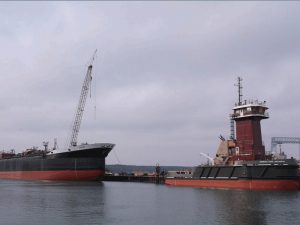
Nichols Brothers Boat Builders recently completed sea trials on the second of 10,000 hp oceangoing tugs for Kirby Offshore Marine, the coastal tug and barge arm of Kirby Corporation, Houston, TX. The 136 ft x 44 ft tug, Tina Pyne, will be connected to the 185,000 bbl ocean tank barge 185-02 built by Gunderson Marine, Portland, OR.
Kirby’s newbuild plan also includes two 155,000 bbl/6,000 hp Articulated Tug Barge (ATB) units under construction at Fincantieri Bay Shipbuilding in Sturgeon Bay, WI, as well as two 120 ft x 35 ft, 4,894 hp tugs being built by Nichols Brothers Boat Builders. Each tug will be powered by two Caterpillar 3516C engines, each rated at 2,447 hp at 1,600 rev/min, with Reintjes reduction gears turning two Nautican fixed-pitched propellers with fixed nozzles. The Reintjes gears were supplied by Karl Senner, LLC, Kenner, LA. The tugs will also have two C7.1 Caterpillar generators for electrical service. Selected deck machinery includes one TESD-34 Markey tow winch, one CEW-60 Markey electric capstan, and one Smith Berger Tow Pin.
Kirby Offshore Marine is the largest U.S. operator of coastal tank barges that provide regional distribution of refined petroleum products, black oil and crude oil. Kirby grew its coastal marine transportation business through the acquisition of K-Sea Transportation Partners L.P. back in 2011 in a transaction valued at about $604 million. At that time, Kirby acquired 58 tank barges (only 54 were double hull) with a capacity of 3.8 million barrels and 63 tugs.
Already the operator of the largest inland tank barges and towboats, Kirby Corporation will grow further with the purchase of Seacor Holdings Inc.’s inland tank barge fleet for about $88 million in cash.
Under the terms of the deal struck last month, Kirby will acquire 27 inland 30,000 bbl tank barges and 13 inland towboats, plus one 30,000 bbl tank barge and one towboat currently under construction. As part of the agreement, Kirby will transfer to Seacor the ownership of one Florida-based ship-docking tugboat.
Kirby Inland Marine currently has 898 active inland tank barges and 243 towboats, with a total carrying capacity of 17.9 million barrels. The primary cargoes transported by this fleet are chemicals, petrochemical feedstocks, gasoline additives, refined petroleum products, liquid fertilizer, black oil and pressurized products.
Kirby President and CEO David Grzebinski, says “Operating primarily in the refined products trade, these assets will be complementary to our existing fleet and will allow us to continue to enhance customer service.”
TRIPLE-SCREW BOATS FOR MID-RIVER
Over the years, Rodriguez Shipbuilding, Inc.’s triple-screw towboats have won a following operating in the shallow waters where the Mississippi River meets the Gulf of Mexico. These Lugger-type vessels are designed with a distinctive aft-cabin.
Mid-River Terminals of Osceola, AR, recently took delivery of a new design towboat from Rodriguez Shipbuilding, Coden, AL. With a conventional forward-house pusher configuration, the new 70 ft x 30 ft MV/ Dianna Lynn uses the same propulsion as the Lugger tugs. This is composed of three in-line six-cylinder Cummins QSK 19 engines, each delivering 660 hp. Each engine turns a 66-inch stainless steel propeller through ZF gears with 6:1 reduction ratio. The combination gives the 1,980 hp towboat an eight-foot operating draft.
Fitted with large windows, the wheelhouse has a full 360-degree view and is set atop two accommodation decks and a half deck that also serves for bridge electronics support. This gives the towboat a 31-foot high eye-level, with full tanks, for working high barges.
Steering and flanking rudders are controlled by wheelhouse levers with mechanical shafts through the houses and connected to the hydraulic actuator valves in the upper engine room.
A set of push knees and deck winches with cheek blocks facilitates barge work. A pair of 55 kW gensets meets the boat’s electrical requirements.
Zero discharge tanks, built integral to the hull, provide storage for treated sewage and all drains. A separate tank handles waste oil.
The M/V Dianna Lynn is the fourth boat in the Mid-River Terminal fleet, all of which are Cummins powered. Owner Rick Ellis said, “We wanted the three engines for redundancy so that even if we loose an engine we still have over 1,200 horsepower.”
The new boat will be primarily involved in fleeting and harbor work, “Rodriguez did a great job and it is a great handling boat,” Ellis added.
BOUCHARD, MORAN EXPANDING FLEETS
As we highlighted last month, Bouchard Transportation’s multi-million-dollar newbuild program is winding down. The Melville, NY, owner is completing the construction of two new 6,000 hp, 310 ft x 38 ft Intercon tugs at VT Halter Marine, Pascagoula, MS. The tugs Morton S. Bouchard Jr. and Fredrick E. Bouchard will be connected to the B. No. 210 and B. No. 220. The two tank barges were the first double hull tank barges built by Bouchard,. Both were built as wire barges, but following their conversion and stretch at Bollinger Shipyards, Inc., both will be Intercon, flat deck double hulls capable of carrying 110,000 bbl of oil.
Moran Towing, New Canaan, CT, expects to take delivery shortly of a 5,300 hp/110,000 bbl ATB unit from Fincantieri Bay Shipbuilding. The Sturgeon Bay, WI, has another 8,000hp/155,000 bbl ATB unit under construction for Plains All American Pipeline, with an option for a second unit, and signed a hotly contested order for another 8,000 hp/185,000 for another earlier last month. That contract includes an option for another.
The new barge will have a capacity of 185,000-barrels with dimensions of 578 feet by 78 feet. The tug will be an 8.000-HP unit equipped with Tier 4 engines—believed to be GE Marine—to meet the latest EPA emission standards.
When complete, the ATB will operate on the U.S. East Coast and Gulf of Mexico.
“We are pleased to have this opportunity,” said Francesco Valente, FMG President and CEO. “This new contract marks an additional expansion of our product portfolio, confirms our ability to win business with new customers in a very competitive market and further consolidates our presence and reach in the U.S. market.”
“This award increases our pipeline of new construction to 10 vessels and provides additional stability to our business,” said FBS Vice-President and General Manager, Todd Thayse. “We are grateful for the confidence that our customers continue to place in our reputation for quality and the strong shipbuilding skills of our workforce.”
Conrad Shipyards, Morgan City, LA, meanwhile, is building the 80,000 bbl ATB unit for John W. Stone, as well as two ATB tugs for Harley Marine Services, Seattle, WA. Conrad Orange Shipyard in Orange, TX, recently delivered the 35,000 bbl Double Skin 315 to Vane Brothers Company. That barge was towed to New York by the Elizabeth Anne, the first in a series of eight 4,200 hp tugs being built by St. Johns Ship Building, Palatka, FL.
Designed by Frank Basile, P.E. of Entech Designs, LLC, the Elizabeth Anne Class tugboat is a close cousin to Vane’s Basile-designed Patapsco Class tugboats, 15 of which were produced between 2004 and 2009. Measuring 100 feet long and 34 feet wide, with a hull depth of 15 feet, the model-bow Elizabeth Anne utilizes two Caterpillar 3516 Tier 3 engines, each generating 2,100 hhp at 1,600 rev/min. Two John Deere PowerTech 4045, 99 kW generators deliver service power to the boat, while a third John Deere 4045 teamed with an Allison transmission drives the chain-driven INTERCON DD200 towing winch.
 ROBERT ALLAN’S LATEST
ROBERT ALLAN’S LATEST
Over the years, world renowned naval architectural and marine engineering firm Robert Allan Ltd. Has successfully teamed with shipyards around the world to bring new innovative tug designs to the market. Its latest is the VectRA 3000 Class Tug, a high performance VSP Tractor tug designed by Robert Allan Ltd in close collaboration with Turkish ship builder Sanmar and Voith Turbo Propulsion. The tug is designed for maximum efficiency in the performance of towing, harbor ship-handling and escorting of large ships. Performance has been verified with extensive model tests at the commencement of the design cycle. The unique propulsion arrangement features high-speed diesel engines connected to the Voith units via reduction gearboxes with integral clutches. With a bollard pull of 70 tonnes, the VectRA 3000 form can generate escort steering forces in excess of 100 tonnes. Additionally, the design has fire-fighting and oil recovery capabilities and is fully MLC compliant.
The VectRA 3000 has been designed exclusively for Sanmar to offer as one of its highly successful stable of progressive tugboats for the world market.
The first vessel in the series, the M/T Ares, built for Italian tugowner Tripmare SpA, was successfully launched at Sanmar’s new Altinova advanced shipbuilding facility this past February.
The tug has an overall length of 30.25 m, beam of 13m, depth of 5.1m, and design draft of 6.1m.
The vessels are built and classed to the following ABS notation: ✠ A1 Towing Vessel, Escort Vessel, ✠ AMS, Unrestricted Service, UWILD, HAB (WB), ABCU Fire-Fighting Vessel Class 1 Oil Spill Recovery – Capability Class 2 (>60° C) (OSR – C2).
Rather uniquely for a VSP installation, the propulsion drivetrain comprises two Cat 3516C high-speed diesel engines, each rated 2,525 kW at 1,800 rev/min, and driving Voith 32R5EC/265-2 cycloidal propellers. The engines are connected to the Voith drives through a pair of Reintjes WAF 863 gearboxes and Vulkan composite shafts, rather than using the more traditional turbo coupling. This combination is smaller, lighter and less costly than the traditional medium speed drive system. The electrical plant consists of two identical diesel gensets, each with a rated output of 86 ekW.
Crew accommodations are all located on the main deck level for optimal crew comfort. There are 4 single crew cabins plus 1 double crew cabin, each with an en-suite bathroom. A comfortable lounge/mess area and galley facilities are also in the deckhouse, with galley stores and laundry room located below the main deck forward.
All towing, ship handling, and escort work is performed using a double drum escort winch and escort rated staple fitted on the aft deck. One drum can store 710 meters of steel wire line, while the other stores 150 meters of synthetic towline. For increased operational flexibility radial type tow hooks are installed on the main deck forward and aft.
As in a traditional tractor configuration, the stern is the working end of the tug, and as such features heavy-duty cylindrical fendering with a course of ‘W’ fenders below. Hollow ‘D’ fenders protect the sheer lines and tie neatly into the ‘W’ fenders at the bow.
The wheelhouse is designed for excellent 360-degree visibility and includes overhead windows. The split type console is biased aft to ensure unobstructed visibility of the working deck (including the winch, staple, bulwarks and fenders) during operations.
CARGILL’s PUSHBOATS FOR THE AMAZON
In Brazil, the construction of a fleet of Robert Allan Ltd.-designed pushboats and barges for Cargill Transportation is nearing completion. To be used for transporting grain products on the Amazon River system, the fleet includes two shallow-draft RApide 2800-Z2 class pushboats built at INACE in Fortaleza, Brazil and 20 hopper barges built at Rio Maguari in Belem, Brazil.
Each of the two new RApide 2800-Z2 Class pushboats are 28m x 10.5m, with a minimum operating draft of 2.2m and normal operating draft of 2.5m. The two sister vessels, the Cargill Cachara and Cargill Tucunare, are designed to push barge convoys on the Amazon River system.
During the early phases of design, extensive CFD simulations were undertaken to optimize the pushboat’s hull shape to minimize total convoy resistance.
This work was completed in conjunction with extensive logistics modeling of the transportation system to optimize the selection of vessels for the desired route and to analyze operational drafts and cargo throughput at various river levels.
The pushboats were designed to ABS and Brazilian NORMAM-02 requirements and are outfitted to the highest standards.
The wheelhouse is designed for maximum all-round visibility with a split forward control station providing maximum visibility to the foredeck working area of the tug as well as to the convoy of barges ahead. Accommodation for up to 13 people is provided onboard and a large galley and mess is provided on the main deck.
The deckhouse extends aft over the main propulsion components, which comprise a pair of Caterpillar 3512B diesel engines, driving Schottel SRP 550 Z-drive units. The drives are fitted in tunnels designed to optimize flow while reducing draft. Two identical Caterpillar diesel gensets are provided in the vessel’s auxiliary machinery space located below the main deck.
The corresponding 61m x 15m box and rake barges were designed by Robert Allan Ltd. to ABS River Rule requirements. Additional extensive FEA analysis of the structure was performed in order to optimize the design for minimum steel weight while ensuring long service life during river operations. Sliding aluminum hatch covers have been supplied to ensure the cargo stays dry at all times.
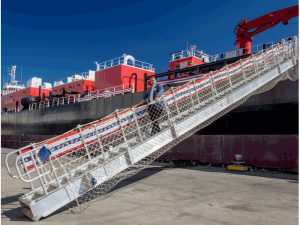
Marine Log: Can you tell us about the founding of the company and how it has evolved over the years?
Morton S. Bouchard III: Bouchard Transportation Co., Inc. was founded and incorporated in 1918 by my Great Grandfather, Captain Fred Bouchard.
Capt. Fred Bouchard became a tugboat Captain at the young age of 14. In 1916, while on watch, the Black Tom explosion occurred on Staten Island, and Capt. Fred maneuvered his tug and pulled ammunition scows out to safety. He was blown out of the wheel house on two occasions, but continued to pull the scows to safety. For his heroic actions, he was awarded salvage money from the state and federal government; and with those funds he bought a coal scow, lived and worked the scow, and created his own company, Bouchard Transportation Company, which was incorporated in 1918.
In 1931, Capt. Fred acquired Bouchard’s first oil barge, a sunken 15,000-barrel vessel, which he purchased for $100. After raising this vessel in Jacksonville, FL, he towed it to a Norfolk, VA, shipyard where it was converted to a hot oil system, oil barge. From there it was towed up to NY Harbor, signifying Bouchard’s first of many vessel purchases and construction projects.
The company was passed on to my grandfather, Morton (“Buster”) S. Bouchard Sr., who continued to grow the company, then was passed on to my father, Morton S. Bouchard Jr., and then on to me. The philosophy has not changed for four generations: Work hard, do not take anything for granted, take care of your customers, and invest the profits into new more modern equipment, and maintain our existing equipment to the highest standards possible.
Sometimes I sit back and wonder about what all three of them (Capt. Fred Bouchard, Morton S. Bouchard Sr., and Morton S. Bouchard Jr.) would think, as the company has grown beyond their imaginations, and will hopefully continue to grow as the 5th generation, Brendan J. Bouchard, becomes more involved.
ML: When did you first begin working at the company?
MB: I began working at Bouchard when I was 19, a sophomore in college. I worked in the shipyards and our outside office. The following summer I worked on the vessels, and the summer after that I was a night dispatcher, filling in for the night staff vacations. When I graduated college, I was a dispatcher, but was also attached to my father’s hip. I was with him for every meeting and important phone call. I became President at the age of 32.
ML: One of the major regulatory challenges for petroleum marine transportation companies was the enactment of the Oil Pollution Act of 1990. Tell us how Bouchard addressed that challenge.
MB: OPA 90 changed our industry in every aspect. When OPA 90 was passed, my father and I had a meeting, and he had the entire bill with him. He asked me if I had read it, and I told him no – not the entire bill, but the most important segments. He was very upset, and felt that Bouchard should sell. After a lengthy discussion, which was mostly listening on my part, I finally got my father to realize that 1990 was the year that we would need to decide what our next business plan would be for the company. From this conversation, I finally convinced my father that we should build double hulls, and be the first company to invest in double hulls, which we did. Bouchard was the first to build double hulls (1992 & 1993), and continues to be the leader in double hulls. All of Bouchard barges are flat deck double hulls, we do not believe in trunk deck barges, and feel that the trunks should not be allowed to carry petroleum, for the trunks are not double hull.
OPA 90 also increased the awareness of safety for trained crew members, as well as shoreside personnel. I continuously tell all of our employees that we cannot be profitable unless we are safe, and we must give every employee the resources needed to be safe.
ML: One of your latest deliveries was the 10,000 hp/250,000 bbl Articulated Tug Barge Donna J. Bouchard and the B. No. 272. Those vessels are some of the last under a major investment in renewing and expanding your fleet. Tell me about your fleet expansion?
MB: Bouchard and Halter have enjoyed a relationship for over 40 years. The management of Halter has changed over those years, however Bouchard and Halter continue our relationship.
The latest expansion program involved two units, M/V Kim M. Bouchard & B. No. 270, and the M/V Donna J. Bouchard & B. No. 272. We felt that there was a market need for vessels of this size, and that ATBs are more economical than ships, and just as safe. We started studying various capacities. We were originally targeting 350,000 bbl and 15,000 hp tugs; however, after many meetings and discussions with our customers, and possible future customers, we decided to scale the size down to 250,000 BBLs & 10,000 HP, which proved to be a smart decision. These two new units bring Bouchard’s fleet to three units this size, all flat deck double hulls: M/V Danielle M. Bouchard & B. No. 245, M/V Kim M. Bouchard & B. No. 270, and M/V Donna J. Bouchard & B. No. 272.

Bouchard also contracted to build two 6,000 hp Intercon Tugs with Halter; M/V Morton S. Bouchard Jr. & M/V Frederick E. Bouchard, and contracted with Bollinger to convert the B. No. 210 & B. No. 220 to Intercon barges with segregated ballast. The B. No. 210 & B. No. 220 were two of the first double hull barges Bouchard built, and were wire barges. Upon the completion of their conversion, I am very proud to say that Bouchard’s entire fleet above 60,000 BBL is flat deck, double hull, Intercon ATBs that range in capacity from 55,000 BBLs (B. No. 250 only 1), then 80,000 BBLs to 250,000 BBLs. No other company has such a modern and safe fleet.
ML: Quality, safety and the environment are clearly issues that are of primary concern to Bouchard. How are those issues addressed in the corporate culture and corporate policy?
MB: Quality, safety, environment, and crew safety are Bouchard’s highest priority. Every employee at Bouchard knows that safety is our highest priority. As I mentioned earlier, Bouchard cannot be profitable unless we are safe. This philosophy is practiced every day, 24 hours, 365 days a year – no exceptions. Every captain in Bouchard’s fleet knows that they have the authority to put the operation on hold if they feel the safety of the crew and vessel is being jeopardized. For example:
When it comes to the safety of the crew and fleet, Bouchard employees know all decisions will have my full support. Safety is the most important policy at Bouchard.
ML: Tell our readers about Bouchard’s work with SUNY Maritime. How did that relationship come about?
MB: Education is of vital importance at Bouchard. It is very simple, the more educated our employees are, the safer we as a company will be. A major aspect of education is simulator training.
New York Harbor was always the home of a simulator, and it was relocated to Houston. When I became aware of this, I was upset with myself for not being aware of it. After speaking with various other companies, I decided that a simulator was needed for ocean going tug & barges. I wanted a simulator that could be used by Bouchard employees, but also by the cadets to learn tug & barge operations while enrolled at school. After several meetings with my dear friends at SUNY Maritime, Bouchard made the proud decision to build the Morton S. Bouchard Jr. Tug & Barge Simulator, which can be used for cadets, Bouchard employees, as well as other companies.
Bouchard’s commitment to this simulator is not one and done, it entrails yearly upgrades to the software, and the simulator itself. We just recently upgraded the software to include tractor tugs, and ship docking, all funded by Bouchard.
This type of commitment just enforces our corporate philosophy that there is no budget for safety and proper training, and safety is our number 1 and top priority.
ML: What would you like the legacy of the Bouchard brand to be?
MB: Bouchard’s legacy should be recognized for the following: